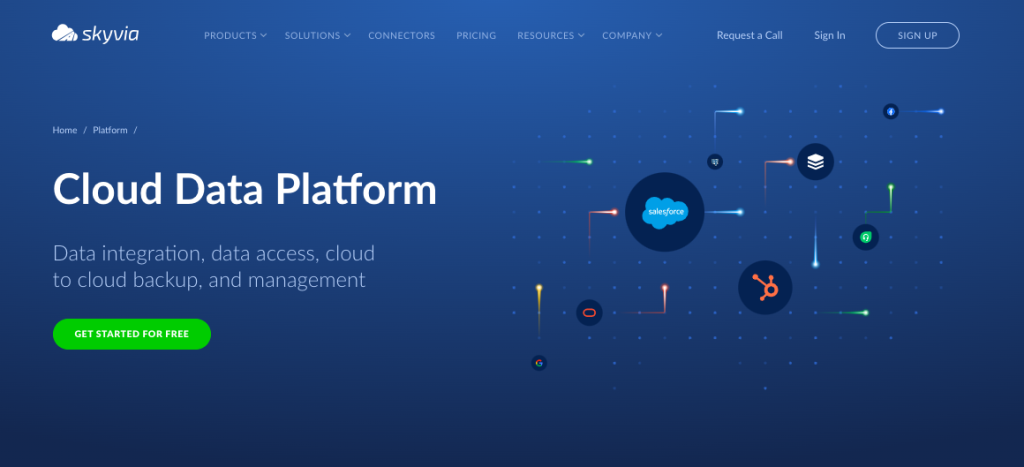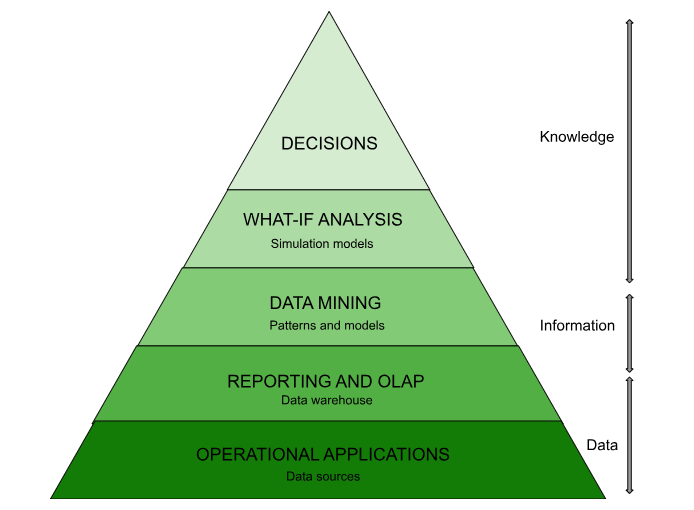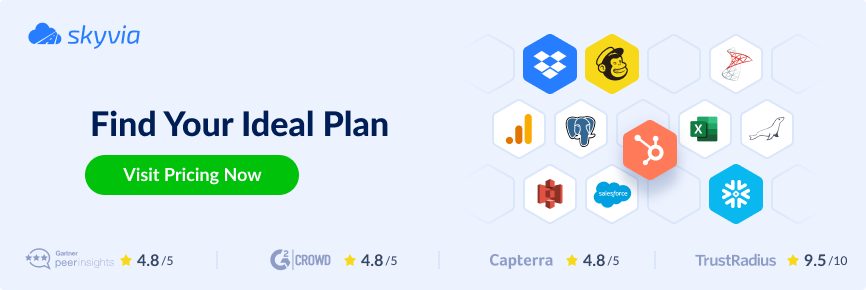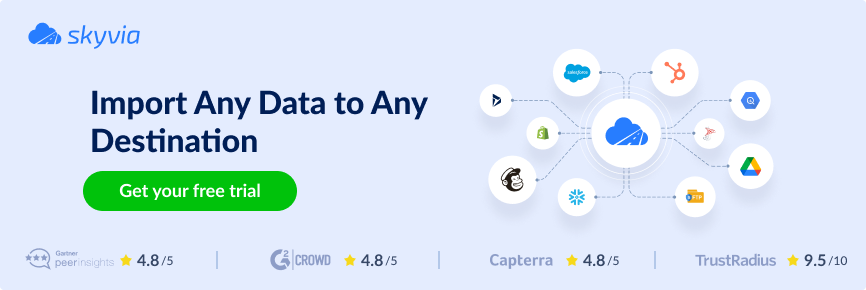Most people think the Gold Rush is over, but it has just changed its appearance and transformed into the Information Rush. Like gold miners doing panning, modern data tech specialists use data mining techniques to find hidden gems in the bulks of data.
Small businesses usually stand aside from data mining, being convinced that this technique is only for ‘big fish.’ Contrary to this belief, data mining suits any company with CRM, e-commerce websites, and social media platforms.
This article provides a comprehensive overview of data mining and explains its correlation with data integration and business intelligence. You’ll also find a list of open-source and commercial data mining tools suitable for any business.
Table of Contents
- What is Data Mining?
- Importance and Benefits of Data Mining for Various Industries
- The Role of Data Integration in Data Mining
- Best Tools for Data Mining
- The Role of Data Mining in BI
- Challenges of Data Mining
- Conclusion
What is Data Mining?
The concept of data mining emerged in the early 1930s, long before the first digital data spikes, but the term was stabilized only in the 1990s. Due to the growing amount of data, the relevance and economic impact of data mining has only been strengthening since then.
So, let’s have a look at the official definition:
“Data mining is the process of discovering patterns from large datasets using specific methods relying on statistics, artificial intelligence, machine learning, and DBMS technology. Data mining in the commercial context helps organizations to transform raw data into useful information.”
Data Mining Process Steps
Getting tangible results from data mining is like climbing the stairs toward the hilltop. You’ll need to put some effort to get meaningful information from datasets.

The data mining process encompasses the following stages:
- Data collection. At this point, it’s necessary to gather all the data of interest and organize it properly. Data warehouses and data lakes are popular for consolidating data.
- Data observation. At this stage, decide which data should be processed further by removing unnecessary columns and applying filters.
- Data preparation. The quality of data is deterministic for the outcomes of data mining. So, it’s necessary to transform data where appropriate, detect any outliers, elaborate on records with missing values, and remove duplicates.
- Choosing a model. Select the data mining algorithms depending on the existing problem and objective.
- Evaluation. Assess the performance and effectiveness of the chosen model using a validation or cross-validation set.
Key Techniques in Data Mining
When climbing a hill, you’ll need some means: hiking shoes, a car, a bike, or even a helicopter. The choice depends on the mountain height, availability of stairs, etc.
Data mining offers a range of techniques that help to achieve the hilltop. They can be grouped into supervised and unsupervised learning algorithms. The most popular and widely used of them are provided below.
Supervised Learning
- Decision trees: This algorithm builds a tree-shaped predictive model. It aims to categorize data considering certain attributes and helps draw conclusions based on observations.
- Regression: This is a group of algorithms used to predict numeric values based on the relationship between input and target variables. It can be useful for estimating profit, sales, mortgage rates, etc.
- Linear perceptron: It uses binary classifiers that can decide whether the input data belongs to a specific class.
- Naïve Bayes: It’s based on Bayes’ theorem, which is used in probability theory and statistics. Naïve Bayes is particularly effective for text classification and spam filtering.
- Neural network: This model is inspired by the structure of the human neural system. It’s widely used in the banking sector to detect fraud on time and in the healthcare industry for disease diagnosis.
Unsupervised Learning
- Clustering methods don’t rely on predefined classes but group data instances together based on their similarities. The most popular clustering algorithms are K-Means, agglomerative clustering, DBSCAN, and DENCLUE.
- Association rules discover data relationships and insightful patterns in the e-commerce industry. For example, given a set of commercial transactions, they can generate rules that predict the occurrence of an item A based on the occurrences of other items (B, C, D, etc.) in the transaction or purchase.
| Transaction ID | Items |
| 1 | Bread, Milk |
| 2 | Beer, Bread, Diaper, Eggs |
| 3 | Beer, Coke, Diaper, Milk |
| 4 | Beer, Bread, Diaper, Milk |
| 5 | Bread, Coke, Diaper, Milk |
Rule examples:
{Diaper, Milk} -> {Beer}
{Beer, Milk} ->{Diaper}
{Beer, Diaper} -> {Milk}
{Beer} -> {Diaper, Milk}
{Diaper} -> {Beer, Milk}
{Milk} -> {Beer, Diaper}
Importance and Benefits of Data Mining for Various Industries
Small businesses are convinced that data mining practices are only available for enterprises. In reality, organizations of any size and operational sphere can benefit from data mining to discover certain patterns from their existing datasets.
Let’s explore the sectors where data mining has become the best friend of decision-makers. We’ll also provide real-world examples showing how both small and big companies use data mining.
Retail
By analyzing thousands of orders, it’s possible to find out customers’ preferences and purchasing habits. What’s more, data mining algorithms allow for carrying out a market basket analysis to find relationships among products often purchased together. This helps to show the right advertisements on the e-commerce platform.
Amazon is the most famous company in the retail industry. It has tons of data processed with data mining tools to craft promotional strategies and enhance customer experience.
Finance
Data mining in the financial sector helps to detect fraudulent transactions and predict mortgage rates. Recently, banks have also relied on data mining to determine the risk profile of a person planning to take a loan.
Healthcare
Data mining algorithms take raw medical data and records and derive certain patterns from it. This positively impacts diagnosis accuracy, treatment efficiency, and clinical decision-making.
One of the examples of data mining advantages for small businesses within the healthcare industry is the Z5 Inventory case. This software development company has helped dozens of healthcare institutions in the US to improve their physical inventory management. Owing to data mining algorithms combined with Z5 Inventory’s solution, it became possible to optimize supply chains, reduce healthcare waste, and minimize costs.
Media
Businesses in the media industry often rely on clustering methods to group similar users and identify trends based on location and time. This information helps them better understand their audiences, explore current market trends, and monitor competitors.
A great example of data mining outcomes for medium-sized businesses is the Allente company case. This Scandinavian television provider has managed to build a content recommendation engine for users and predict the likelihood of customer churning.
Energy
General Electric Vernova collects machine-generated data from sensors on gas turbines and jet engines. Elaborating on these large datasets with data mining tools enables the company to improve working processes and strengthen reliability.
Logistics
Classification algorithms applied to logistics datasets can reveal the best supply chain partners. They also help to discover and compare possible routes between points A and B to improve transportation efficiency. Meanwhile, neural networks are efficient for forecasting demand and inventory optimization.
The Role of Data Integration in Data Mining
Data integration is the process of combining and harmonizing data from multiple sources into a unified, coherent format that can be put to use for various analytical, operational and decision-making purposes. (IBM)
The first step is to collect data that was produced by:
- Humans: User-generated data from social media platforms (text, photos, videos), emails, documents, clickstream data, etc. It’s usually unstructured or semi-structured and needs preprocessing.
- Organizations: Commercial transactions, banking records, e-commerce records, medical records, etc. form up the organizational data.
- Machines: This is data coming from sensors (traffic, weather, scientific, etc.) and computer systems (logs). It’s well-structured and thus suitable for computer processing.
Raw data isn’t always 100% suitable for analysis in its original form, so it needs to be preprocessed beforehand. Data integration tools, such as Skyvia, have transformation functions, allowing to prepare data properly.
The final step of data integration is to move data to a data warehouse (commonly used by data mining specialists) or another destination of interest. A data warehouse is also a place for consolidating data from various sources.

Skyvia is the universal SaaS platform capable of resolving various data-related tasks. It offers a range of solutions for data integration, backup, automation, querying, and connectivity.
The Data Integration product was designed to transfer data between different cloud apps, databases, and data warehouses. It also provides multiple data transformation, cleansing, and mapping capabilities.
To prepare supply data mining algorithms with proper datasets, Skyvia offers the following solutions:
- Import is a wizard-based tool for a no-code integration of two data sources. It builds refined ETL pipelines that ingest data from the source and send it to the selected destination. It can also apply filtering, transformation, and mapping for the given data. The Import tool is suitable for getting data ready before mining.
- Replication tool allows users to create ELT pipelines that ingest data from the selected source and move it to the destination in its original form. Such practice is common these days as it ensures faster data load as transformation is skipped on integration and applied on the destination side later. See ETL and ELT differences.
- Data Flow tool is a visual constructor of ETL pipelines with 2+ sources. It offers complex data transformations for data preparation and many advanced features.
Data Integration Use in Data Mining
Now, let’s examine how data integration with Skyvia assists data mining.
- Unified data view. Data integration tools gather data from cloud applications, on-premises services, databases, and DWHs and take it to a centralized location. Consolidated data gives data scientists, data engineers, and business analysts a unified view.
- Improved data quality. The ETL pipeline designer tools provide filtering, transformation, and cleansing functions for enhancing the overall quality of data. As a result, data mining algorithms applied to refined datasets ensure correct results.
- Automation. Modern data integration services and platforms allow users to load and update data on schedule. This helps to automate processes, speed up data movement, and exclude manual work.
Best Tools for Data Mining
Now, it’s time to switch to the bread and butter of the data mining process – data mining tools. Find the best software for elaborating on datasets with a concise feature overview, advantages, and drawbacks.
| Tool | Features | Advantages | Drawbacks |
|---|---|---|---|
| RapidMiner | 1. Data preparation 2. Deep learning 3. Text mining 4. Predictive analytics | 1. Extensive community support 2. Highly customizable | Steeper learning curve for beginners |
| Weka | 1. Data preparation 2. Data visualization 3. Clustering 4.Classification5.Regression | 1. User-friendly UI 2. Supports small and medium datasets | Limited scalability for large datasets |
| Orange Data Mining | 1. Data visualization 2. Component-based data mining | A limited number of advanced features | Limited number of advanced features |
| Scikit-learn | 1. Classification 2. Regression 3. Clustering 4. Statistical modeling 5. Data preprocessing | 1. Built on Python 2. Excellent documentation | Requires programming knowledge |
| IBM SPSS Modeler | 1. Advanced statistical modeling 2. Text analytics | 1. No coding 2. Excellent support | 1. Expensive 2. Steep learning curve |
| SAS Data Mining | 1. Data preprocessing 2. Machine learning 3. Text mining | 1. Comprehensive solutions 2. Excellent support | 1. Expensive 2. Difficult in use |
| MATLAB | 1. Mathematical modeling 2. Simulation 3. Algorithm development | 1. Extensive toolbox 2. Strong community support | Requires programming skills |
| H2O.ai | 1. Automated machine learning 2. Deep learning | 1. Scalable 2. Supports multiple languages | Requires programming skills |
| DataRobot | 1. Automated machine learning 2. Enterprise AI | 1. No coding required 2. Excellent scalability | 1. Expensive 2. Limited scalability |
The Role of Data Mining in BI
It’s easy to get perplexed by the variety of operations that can be performed on data. So, data mining is often mistakenly taken as business intelligence (BI) or business analytics. In fact, there are many things in common among them, but there are still more differences than similarities between data mining and BI.
Let’s explore what business intelligence (BI) is by looking at how Forrester Research defines it:
“BI is a set of methodologies, processes, architectures, and technologies that transform raw data into meaningful and useful information used to enable more effective strategic, tactical, and operational insights and decision making.”
Now, let’s examine the pyramid, which contains all the stages of the business intelligence processes. It will help you understand the role of data mining in BI and the correlation between these two notions.

Operational applications. We have already reviewed the first step of the pyramid: data collection from various tools and its consolidation within a data warehouse using the ETL and ELT tools.
Reporting and OLAP. OLAP analysis allows users to interactively navigate through the DWH using a number of operations: roll-up, drill-down, pivoting, slice-and-dice, drill-across, and drill-through. That way, all the necessary information is extracted for being processed with the selected algorithm.
Data mining. The most commonly used data mining algorithms with the examples are provided above.
What-if analysis. It’s a data-intensive simulation with the goal of inspecting the behavior of a complex system under some hypotheses. For example, if marketers want to know how their promotional campaign would run, they should build a simulation model. This model must be able to express the complex relationships between the business variables determining the impact of promotional campaigns on product sales. It’s necessary to run this model against the historical sales data in order to determine a reliable forecast for future sales.
Decisions. Based on the information obtained, business leaders arrive at the top of the BI pyramid to make decisions.
Now, it’s obvious that data mining can’t be interchangeably used with BI because it only makes a part of it.
Challenges of Data Mining
Despite its numerous benefits, there are certain difficulties data mining specialists encounter. Here are some of the most common ones:
- Data heterogeneity. Each online service and app has its preferred format for storing data. Merging data from different platforms might be challenging.
- Noisy and incomplete data. When dealing with datasets for data mining, there’s a need to detect outliers, find records with missing values, etc. This is crucial because data duplicates and other anomalies can significantly impact the final pattern discovery.
- Background knowledge. Data mining has complex algorithms that require a solid statistics and programming base.
- Complexity of operations: Data mining specialists need to pick the right algorithms for a specific case and perform a set of cross-validation procedures to determine its effectiveness. Moreover, much practice is required to interpret the data mining outcomes correctly.
- Ethical and legal considerations. Unauthorized individuals might access sensitive information in data sets and expose it. There are also insider threats from internal stakeholders that may lead to data leaks. All this imposes a risk on data security and privacy. To address this challenge, data mining practitioners usually apply data anonymization. Moreover, organizations need to adhere to GDPR, CCPA, and HIPAA privacy regulations to impose rules on data collection, utilization, and sharing.
Conclusion
Data mining gains momentum because of the insights it uncovers for companies. It suits businesses of any size in various sectors of the economy. Data mining algorithms will work well as long as your company generates considerable data volumes and is widely represented over social media.
Data mining is also perceived as complex and demanding, but modern tools simplify everything. This refers to data mining tools that apply supervised and unsupervised algorithms on datasets as well as data integration tools that make up a strong foundation for data mining. Therefore, try Skyvia for data integration today to ensure the best data mining results in the future.


